ASRock X670E Steel Legend ATX Motherboard Review
ASRock shoots straight for value by charging only $300 for a package that uses AMD’s X670 chipset pair to host what appears to be a typical high-end interface assortment, includes a 16-phase voltage regulator with 960 amperes of combined output, and adds a graphics card brace. The graphics card brace certainly isn’t expensive, but given the expense that goes into routing all those pricey pieces of silicon across the X670E Steel Legend’s eight PCB layers, it’s a nice addition.

| ASRock X670E Steel Legend | |||
| Socket | AM5 | Form Factor | ATX |
| Chipset | AMD X670 |
Voltage Regulator |
19 (16+2+1) Phases |
| Rear I/O | |||
| Video Ports | DisplayPort 1.4 (4k/120Hz Max), HDMI 2.1 (4k/120Hz Max) | Audio Jacks | (2) Analog, (1) Optical SPDIF |
| Rear USB 3.x | (1) 20Gb/s Type-C, (1) 10Gb/s Type A, (6) 5Gb/s Type A | Legacy Ports/Jacks | (4) USB 2.0 |
| Network Jacks | (1) GbE, (1) 2.5GbE | I/O Panel Extras | BIOS Flashback Button |
| Internal Interface | |||
| PCIe x16 | (1) v5.0 x16, (1) v3.0 x4 | SATA Ports | (4) 6Gb/s |
| PCIe x8 | ✗ | USB Headers | (1) v3.x Gen2x2 (20Gb/s), (2) v3.x Gen1, (2) v2.0 |
| PCIe x4 | ✗ | Fan Headers | (6) 4-Pin |
| PCIe x1 | (1) v3.0 (open end) | Legacy Interfaces | UART (3-pin), System (Beep-code) Speaker |
| CrossFire/SLI | 2 / ✗ | Other Interfaces | FP-Audio, RGB LED, (3) ARGB LED, Thunderbolt AIC, TPM |
| DIMM slots | (4) DDR5 | Diagnostics Panel | ✗ |
| M.2 slots | (1) PCIe 5.0, (3) PCIe 4.0 x4 | Internal Button/Switch | ✗ / ✗ |
| Controllers | |||
| SATA Controllers | Integrated | USB Controllers | Integrated |
| Ethernet Controllers | RTL8111H GbE PCIe, RTL8125BG 2.5GbE PCIe | HD Audio Codec | ALC1220 |
| Wi-Fi / Bluetooth | AMD RZ616 Wi-Fi 6E (2.4 Gb/s) / BT 5.2 Combo | DDL/DTS Connect | ✗ |
Get it at Amazon

(click for availability)
AMD’s X670E is the first double chipset we’ve seen since the ULi AP9567A of 2005, and looking at AMD’s block diagram to see why two devices were needed raised more questions than answers. The X670E Steel Legend’s pathway chart shows that AMD’s X670 is nothing more than two of its B650 bridges strung together, so of course we’ll take more photos as we dig deeper.

The Steel Legend’s extensive use of aluminum heat sinks doesn’t surprise us given the need to cool two separate PCIe 4.0 controllers, and the only spot ASRock leaves bare is its central NVMe slot. That was probably done to provide more room around the graphics card cooler, as the lower two PCIe 4.0 and upper PCIe 5.0 NVMe storage slots all have stylish heat sinks to match those of the chipset and voltage regulation components.

The X670’s dual motherboard bridges gave ASRock the ability to put native USB3 Gen2x2 on the rear panel as well as the front, boosting bandwidth from the single-link Gen2’s 10Gb/s to the dual link 20Gb/s. The board adds a 10Gb/s Type-A port, 4K/120Hz support for both of the CPU’s graphics outputs (DisplayPort and HDMI), AMD’s 2.4Gb WiFi/Bluetooth, dual ethernet with one port boosted to 2.5GbE spec, six 5Gb/s USB ports, a BIOS flashback button, an SPDIF output and…four USB 2.0 ports. We appreciate that USB 2.0 is nearly free and full-spec compliant with keyboards and mice, so perhaps its inclusion of only two analog jacks on Realtek’s high-end ALC1220 7.1-channel controller is the Steel Legend’s greatest I/O panel weakness.

The front USB3 Gen2x2 connection is located next to the old USB3 Gen1 connector near the center of the X670E Steel Legends front edge. That center “Hyper M.2” storage slot looks even more bare from above, while the open end of the PCIe x1 slot next to it also becomes more apparent. There’s enough space between the PCIe x1 slot and CMOS clock battery to fit a PCIe x8 card…if ever you want to run one in x1 mode.
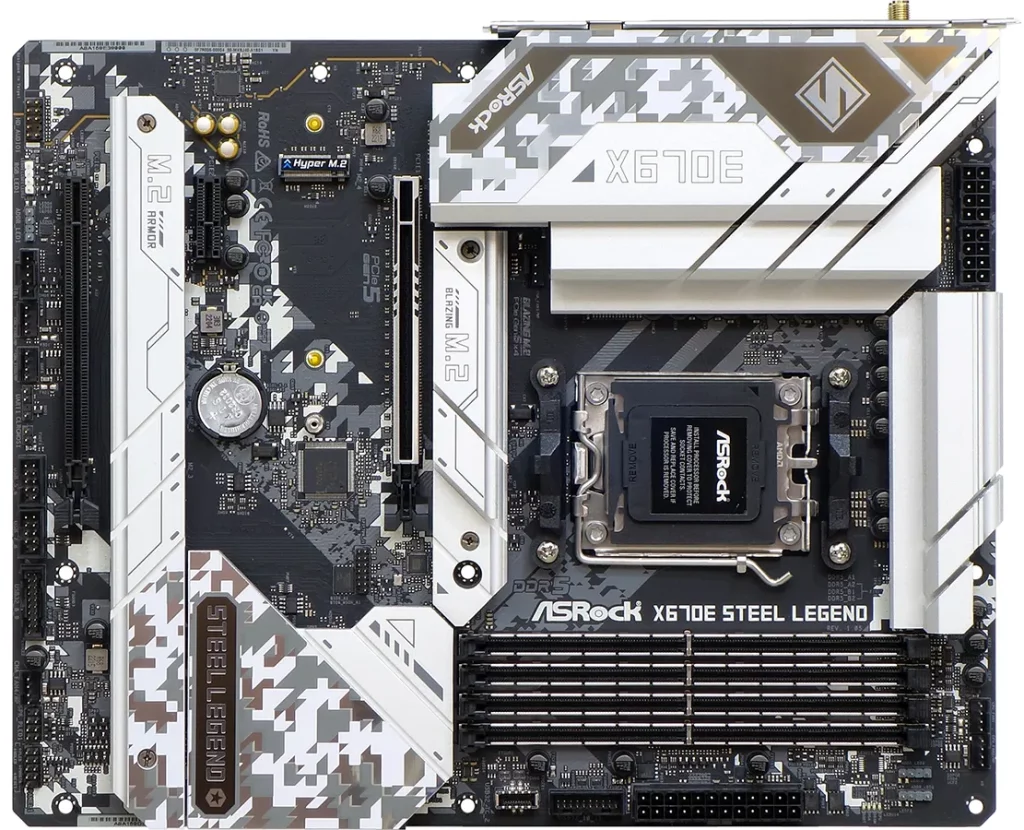
Removing the heat sinks reveals both chipset components and may even answer a few questions about why ASRock decided not to fill out its I/O panel with a few more audio jacks to fit your old analog 7.1 speaker system: The board is very crowded around that connector. A PCIe x1 / USB connection runs up the back of the Steel Legend to a riser card that holds the Key-E Wi-Fi / Bluetooth module perpendicular to the motherboard’s surface.

An RAA229628 PWM controls nineteen ISL99360 60A MOSFETs, sixteen of which ASRock dedicates to powering CPU cores via two 8-pin “ATX12V” (classically EPS12V) connectors.

The X670E Steel Legend’s north (ie upper) end includes one chipset bridge as well as two of the front-panel USB3 connectors (a Gen2x2 and a Gen1). Two ARGB connectors are just south of the upper front corner, two 4-pin fan connectors are just behind it, a third fan connector is found just south of the rear voltage regulator bank, and a PI3EQX2004 USB3 Gen2x2 redriver is found just south of the forwardmost DIMM. The NVMe 5.0 storage slot is situated mid-board.

The X670E Steel Legend’s south (ie lower) end features a PCIe 5.0 x16 slot, the previously mentioned PCIe 3.0 x1 slot, a PCIe x16 slot with only four version 3.0 lanes, an NVMe 4.0 slot just below the upper x16 slot, two NVMe 4.0 slots between the x1 and lower x16 card slots, and a variety of cable connectors. Four SATA 6.0 ports face forward from the front edge. The bottom edge features headers for front panel HD Audio, legacy RGB, ARGB, a Thunderbolt add-in card (which would occupy the four-lane slot), two additional PWM fan, an undocumented UART header, a CLR CMOS jumper, two dual-port USB 2.0, a dual-port USB3 Gen1, yet another PWM fan, a combo header with 4-pin PC Speaker and 3-pin Power LED connections, and an Intel -style front-panel button/LED group.

The two chipset components are identical, but we don’t know whether the numbers differentiate the X670 from our previously tested B650 sample or whether these are just date and production codes.
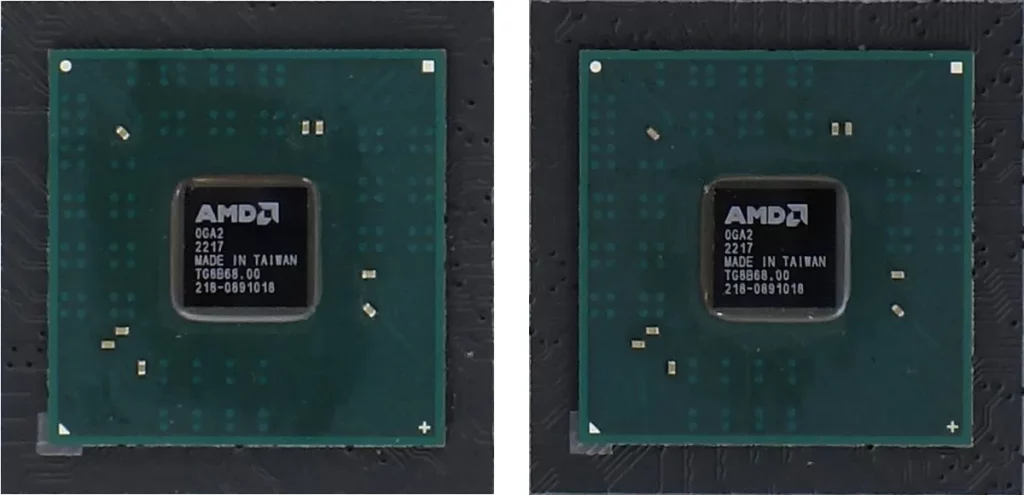
Included with the X670E Steel Legend are a printed manual, a postcard, two SATA cables, the graphics card support bracket, a dual channel Wi-Fi antenna, two hook and loop cable straps, a Steel Legend keyboard key, and enough screws to secure four M.2 drives and the card bracket.

Software
ASRock includes a software installer that’s activated in BIOS, but that’s just for the drivers and driver controls. Available on the motherboard website, ASRock Appshop provides links to its other utilities.


Polychrome Sync addressed the motherboard’s two lighted sections: Unfortunate for this portion of the review is that our memory didn’t have any RGB to address. Also shown is ASRock’s Restart to UEFI, which does what its name implies.


ASRock A-Tuning worked fine for adjusting frequency, but hung when we tried to adjust voltage. It’s System Info tab showed the same numbers as the popular HWiNFO third-party suite, and its FAN-Tastic Tuning app worked as expected.




Firmware
AMD released a major patch in October and while we tried to wait for ASRock to release a non-Beta version of its patched firmware, none exist two months later. A string of beta launches makes it appear that ASRock will always finds something to add before it gets around to releasing a final version, so we finally gave up and broke our policy of not using beta firmware by installing version 1.14 beta 6.
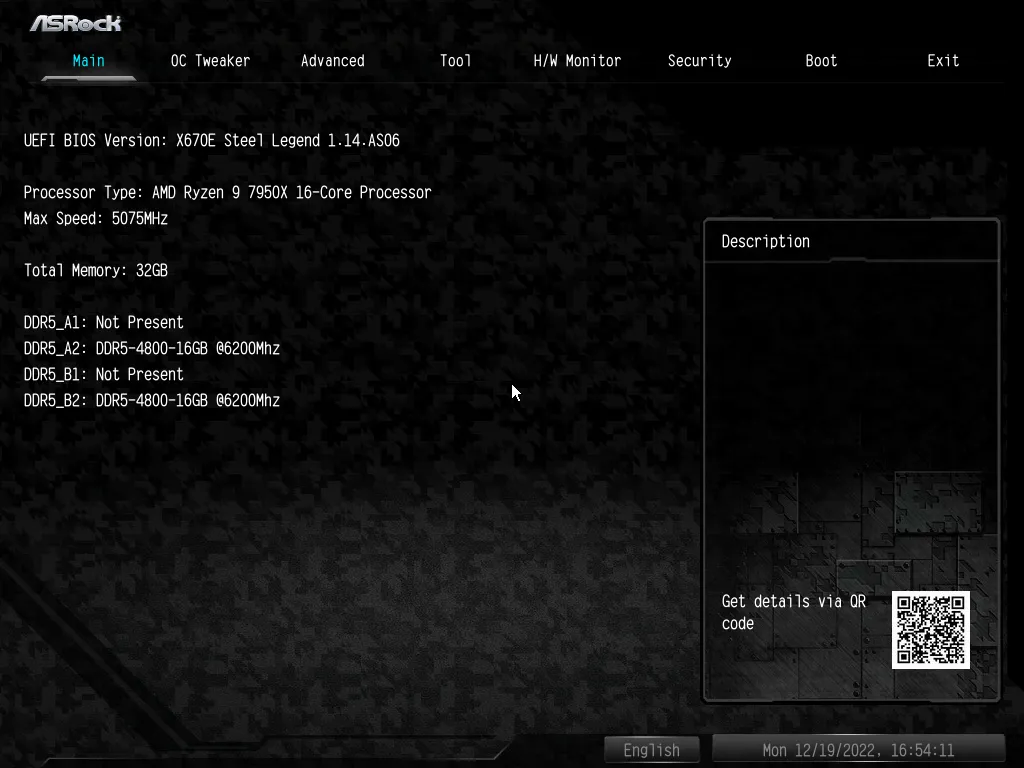
We benchmarked the X670E Steel Legend with our memory running at its EXPO-6000 profile and the board in both standard and baseline PBO modes. Manual overclocking got us a little farther, which we’ll detail momentarily.


We found storage for up to ten custom firmware configurations as user profiles in at the bottom of OC Tweaker, along with apps to export and import profiles using a thumb drive.


The Steel Legend reads and configures both AMD EXPO and Intel XMP memory overclocking profile, the former being present on this particular memory kit. These are read from a table on a small flash IC of each memory module and reported in the firmware’s DRAM Profile Configuration submenu.

Primary and secondary timings are fully adjustable from the DRAM Timing Configuration submenu, but tertiary timings are barely touched on this firmware.


Our Zen 4 overclocks are limited by CPU thermal conditions and we reached those limits using nothing but basic voltage adjustments. Those who prefer to flatten out their voltage levels for stability under a wider range of loads or allow more fluctuation for greater efficiency at low loads will find the necessary adjustments under the External Voltage Settings submenu.

Those with the patience to learn the AMD Overclocking menus will be rewarded with a slightly more extensive set of overclocking controls with names that only make sense to the initiated.




The Tool menu includes an RGB LED control submenu that, when set to a single-color pattern, allows users to color their pattern based on RGB values. Rainbow mode controls are limited to speed and brightness. Other tools allow users to initiate a firmware flash or erase a flash-based drive. The Auto Driver Installer option enables or disables the tool popup in Windows, automatically switching to “Disabled” after first use.




As is typical of ASRock, the Hardware Monitor menu leaves a little to be desired regarding voltage reports but still offers an excellent selection of fan controls. ASRock Fan Tuning runs an algorithm to automatically configure fans based on how far each can be slowed before it no longer rotates on its own, while Fan-Tastic provides a fan slope (RPM to temperature setting) graph.




| Test Hardware | |
| CPU | AMD Ryzen 9 7950X: 16C/32T 4.5-5.7 GHz, 64MB L3 Cache, Socket AM5 |
| CPU Cooler | Alphacool Eisblock XPX CPU, Eisbecher D5 150mm, NexXxoS UT60 X-Flow 240mm |
| DRAM | G.Skill F5-6000J3038F16GX2-TZ5N 2x16GB (32GB) DDR5-6000 CL30-38-38-96 1.35V |
| Graphics Card | Powercolor Red Devil Radeon 6750 XT: 2324-2623MHz GPU, 12GB GDDR6 |
| Power | be quiet! Dark Power Pro 10 850W: ATX12V v2.3, EPS12V, 80 PLUS Platinum |
| Hard Drive | Sabrent Rocket 4 Plus 2TB PCIe 4.0 M.2 SSD |
| Sound | Integrated HD Audio |
| Network | Integrated Wi-Fi |
| Graphics Driver | AMD Adrenalin Edition 2022.10.1 |
Our AM5 test system adds the recently reviewed Ryzen 9 7950X to the graphics, memory, and drive upgrades of our Zen4 launch article.
Overclocking
The word “Overclocking” doesn’t seem to have much meaning when everything on the market uses variable frequency to run programs as quickly as possible within a given thermal envelope, and indeed the Ryzen 9 7950X is rated up to an almost fictitious 5.7 GHz under a load that’s both great enough to trigger automatic overclocking and small enough to not cause overheating. If that’s not enough to make most people throw their hands up and quit, AMD adds “Precision Boost Overclocking” mode to make the CPU do whatever automatic overclocking it’s already doing…even better. And if that doesn’t make most people give up on CPU overclocking, there are the dirty tricks by overclockers themselves who often chose less strenuous applications to supposedly prove stability. Cinebench is one of the favored applications that’s less strenuous than, say, Prime 95.

What we see is that Cinebench allowed us to run up to 5425 MHz before hitting our thermal threshold, and keeping it stable at that frequency and stress level required a 1.30V CPU Core setting. Additional voltage up to 1.315V didn’t allow us to reach the next clock setting, and 1.32V caused what appeared to be an overcurrent protection reset. Meanwhile, Prime95, being more stressful, reached the same thermal limit at 5075 MHz and 1.18V, where the 1.20V that was initially needed to stabilize a 5100 MHz clock eventually caused a thermal limit shut down.
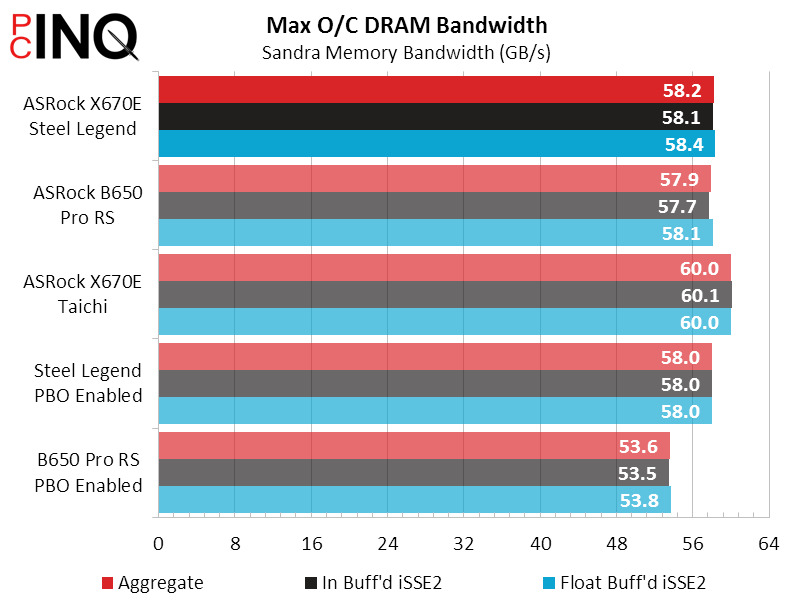
Memory is the space where real overclocking advantages are to be found, but much of the memory on the market is already programmed with an overclock via Intel XMP or AMD EXPO. Still, we managed to get a minor increase in bandwidth by pushing this EXPO-6000 kit to DDR5-6200.
Benchmark Results
The X670E Steel Legend started out with a bit more memory bandwidth than previously tested motherboards, which we believe is likely due to its more-mature firmware. It also came with the worst Sandra Memory Latency however, and it also underperformed the rest of the pack in AIDA64 memory tests.




Losses in memory synthetics were probably too small to matter, and the Steel Legend shows a comeback in 3DMark Time Spy which is also probably too small to matter. Its lead in 3DMark Storage is not as easy to dismiss.




Slightly lower App Start-Up scores are certain to hurt the Steel Legend’s overall performance score, but it again shows strong performance in the benchmark’s drive test.




F1 2021 performance should be memory restricted with a card this powerful, yet our memory is so fast that it’s results really don’t make sense. All of these oddball results have been retested, and continued to show performance patterns that can’t be pinned down based upon other benchmark results.
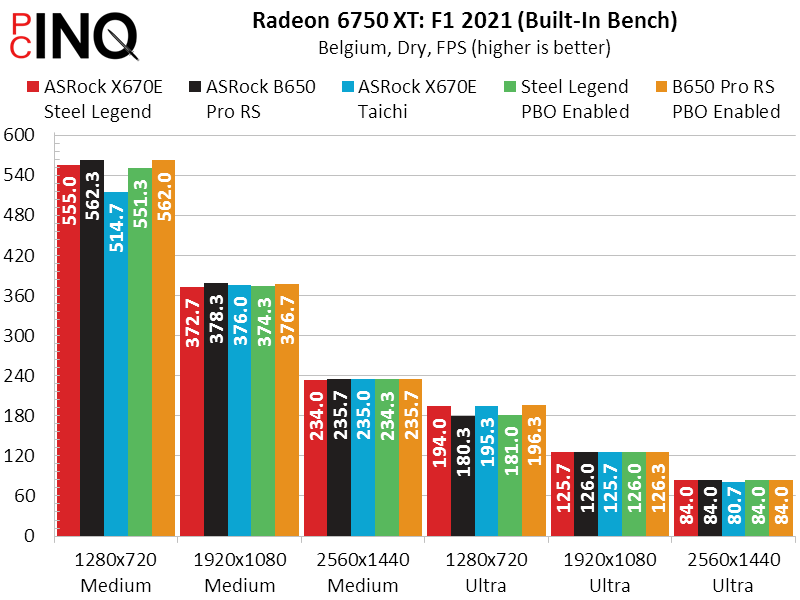
7-Zip is primarily affected by memory, but in this case our memory performs so well that the Steel Legend’s miniscule win is likely due to its phenomenal drive performance. Other benchmarks are not so eager to show such leadership.




When comparing B650 Pro RS power consumption, two things that stand out about the X670E Steel Legend are that it appears to consume two more watts regardless of load at stock settings, and that it returns to full idle even after enabling PBO. As with the X670E Taichi, the B650 Pro RS’s PBO idle power issue is likely related to its earlier firmware.


Differences in drive performance level became so apparent this time around that we had to add it to the overall performance score. We picked 3DMark’s drive test since we are fully aware of how this test represents real-world games, but could have just as easily picked PCMark had we taken the extra time to similarly confirm its results.


The X670E Steel Legend brought us several advantages in general over its competition, including a 25MHz-higher overclock, 2.4% greater performance, and 8.5% improved efficiency. While the tiny overclocking improvement and much of its added efficiency is likely due to its more mature firmware, a portion of that performance gain is due to a big advancement in drive performance that can’t be as easily dismissed.
| ASRock X670E Steel Legend | |
| Pros | Cons |
|
|
| The Verdict | |
| Cramming all of its connectivity, performance and efficiency advancements into a $300 package, the X670E Steel Legend is a top value for those who aren’t trying to connect an analog 7.1-channel speaker system. | |
Get it at Amazon

(click for availability)
Regardless of how much credit goes to the new firmware (which will eventually reach other boards) and how much is due to motherboard design, the X670E Steel Legend carries all of those benefits without indicating significant deficits. Being this good for only $300 makes the X670E Steel Legend a bargain.

